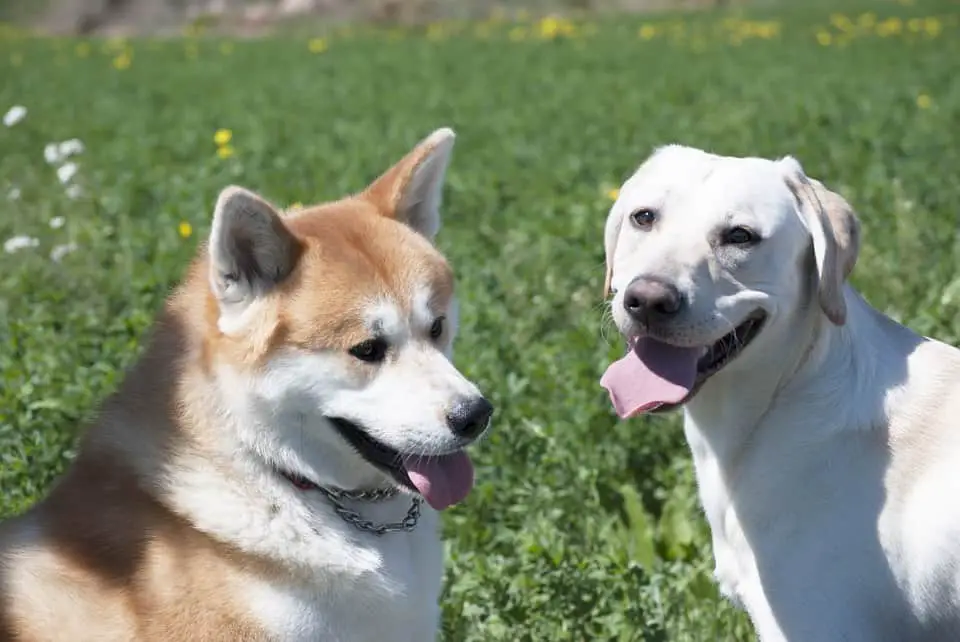
Akitas as a breed have a somewhat complicated reputation. You might wonder if Akita is aggressive toward other dogs.
Akitas could be aggressive with other dogs because they are reactive and protective of their territory and family. Desensitization to triggers and socialization is essential for these dogs. Obedience training and knowledge of commands are important in teaching your Akita to get along with other dogs.
It is important to understand the typical personality of an Akita and note any particular triggers to target aggressive behaviors toward other animals.
Akita’s Temperament
Akitas are sweet and cuddly with their families and animals with which they are familiar. However, Akitas are infamous for acting aloof, suspicious, and defensive in the presence of strangers, including dogs they do not know.
An inexperienced dog owner might find taking care of an Akita challenging. A dog of this breed requires consistent training, and a supportive environment to blossom into a pet that is amicable with other pets and people.
Working Intelligence of the Akita
A renowned canine psychologist Stanley Coren ranked about 130 breeds according to their working intelligence and obedience scores. The rankings are based on evaluations of multiple trainers and judges who scored different breeds independently.
Coren says Akitas are more trainable than one-quarter of all the ranked breeds. In other words, three-quarters of all breeds learn easier. That puts Akitas at the bottom of the group with average working intelligence and right above the group considered fairly trainable.
Responsiveness to Training
In practical terms, an Akita does have some challenges to overcome when learning new behaviors:
- An average Akita might take up to twenty-five repetitions to understand a basic command somewhat.
- The dog may need up to eighty repetitions to understand a command consistently.
- Akitas must practice skills regularly, otherwise, they could forget even the skills they mastered well.
- Teaching Akitas requires patience because they often act independently and are distracted during training.
- The dog could listen and understand the owner well but behaves differently when the owner is farther away or in a new environment.
The quality of training and skills of the trainer him or herself impact the outcomes of average and subaverage breeds much more than it would impact a highly trainable breed.
Coren emphasizes that there is plenty of individual variability within any particular breed. He provides examples of dogs of breeds that are subaverage for working intelligence per their breed but went on to become highly socialized and skillful dogs. So, the breed means a lot but the environment in the household has plenty of corrective power.
COMMON TRIGGERS OF AGGRESSIVE BEHAVIORS IN AKITAS
Dogs of the Same Sex
It is common for Akitas to act aggressively towards large dogs of the same sex.
The dog feels competitive and territorial. Typical behaviors include growling, barking, and charging at the other dog. If the other dog is in fighting mode, the Akita could attack.
Protective of Their Pack And Resources
Akitas are protective of their people and home. They are fabled for their loyalty.
Behaviors that can be mistaken for aggression, including barking, growling, and even chasing, often occur when your dog hears a noise outside or sees another dog walking by.
The tendency to be defensive and dominant persists outdoors. Many Akitas need to be kept on a close leash if someone is walking by, with a dog in particular, until the Akita is trained and reliably desensitized to unfamiliar dogs, people, and any other triggers.
Specific Triggers
Like most dogs, Akitas could be triggered by specific objects for a reason or none.
Many dogs who remember something traumatic can transfer their reaction to any subject reminding them of that memory. For example, some dogs only react to one specific breed or type of dog if there is an altercation with a dog that looks like that in the past.
Running people, dogs, and even moving cars can be a trigger for many dogs, in general. That becomes a serious concern if your Akita is a running partner you bring along to jog or hike with you.
Avoiding the triggers until your dog is properly trained is important.
Strong Prey Drive
Akitas have a strong prey drive.
It is common for these dogs to bond with cats or small dogs in their household but react to and chase small animals outside. Such encounters could be dangerous, given the instincts and the imposing size of Akitas. So, unless your Akita is well-socialized and trained, these pups need close supervision around small animals.
Fear
Akitas could appear aggressive when they feel threatened, by a larger dog, for example. Aggression as a response to fear is quite common for dogs of many breeds and other species, so it is not an Akita-specific problem.
AKITAS AND OTHER DOGS
A typical well-socialized Akita may still have some behavioral problems around other dogs. There are three situations in which Akitas are likely to show some spirit inappropriately:
- Akita sees an unfamiliar dog next to the owner: a natural guarding animal. Akitas are protective of their owners and can act aggressively with other dogs if they perceive them as a threat to the owner.
- Many Akitas do not tolerate other animals in their home. They may be outright aggressive with any animal visiting or joining the household.
- The Akita and the other dog should meet each other under close supervision and then be allowed to have more independent interactions, as tolerated.
- The evaluation period should be extensive and the dogs should be observed in several situations, particularly when they are both eating.
- Male Akitas can be especially unfriendly towards other large male dogs. Female Akitas can also show a lot of hostility, especially around female dogs.
HOW TO CORRECT AGGRESSIVE BEHAVIORS IN AKITA DOGS
Consider Using a Muzzle
Until you feel that your Akita is trustworthy around other dogs, as well as other animals and people, your pet needs to get used to wearing a muzzle. It is a question of safety.
Your dog might initially hate the idea but will get used to the muzzle over time. Have your pet wear it at home for practice, just like any other gear, such as dog booties or a cooling vest.
Shifting Attention Method
A very effective method to address reactivity, to other dogs, in particular, is shifting your dog’s attention.
- When you are walking your dog and there are any stimuli nearby that seem to excite your pet, give your Akita a command, such as “here”. The idea is to make your dog look away from the stimulus. Trying to focus the dog’s attention on you is especially effective.
- Reinforce the distraction with a treat in the beginning.
- If your pup responds well to getting distracted this way, you will not need to provide a treat for much longer. Your Akita will accept a command or any sound of your choice as a substitution.
- If successful, you could train your Akita to switch focus with a brief command.
How to Address Aggression And Reactivity
If an adult dog is generally aggressive towards people or animals, it may be beyond the owner’s ability to impact te animal to a sufficient extent. It could be a situation that warrants attention by a professional dog trainer or canine behavior specialist.
Usually, however, when owners speak about aggression in their dogs, they refer to reactivity, which can be addressed at least in a targeted manner.
Tips on Changing Specific Behaviors
- Provide the dog with plenty of opportunities for activities and exercise
- A dog who is busy, engaged, and tired at the end of the day is less likely to erupt at another dog or act aggressively in general
- Provide socialization
- If your Akita is exposed to other dogs, people, bicycles, cars, and so on, she is less likely to react to them. Socialization is important for all pets but Akitas are among the breeds that need ample interaction with other animals and people more than other dogs.
- Puppy classes
- The same is true about interactions with other puppies: puppy classes are useful for dogs of any breed but an Akita may benefit greatly from learning how to interact appropriately when they are still young. Given the strength of these dogs, even as puppies, they must learn early on when biting or jumping is not appropriate.
- Verbal commands
- Choose a command and use it every time you want a behavior to stop. Understanding words and learning commands is not a forte of this breed, so prepare to be patient and methodical.
- Impulse control
- You could start by playing a fetch game. See if you can get your dog to sit calmly for a few seconds before throwing the ball. Reward the behavior, especially if she is beginning to learn. Patience is a transferable skill, so if your friend learns to control herself when playing fetch, she is more likely to be reserved in other situations.
- Pick the right time
- It may be worth postponing the training if your dog is overly excited. Most dogs are more receptive when they are either calm or moderately excited.
- Introduce triggers in a controlled environment
- If your Akita is reactive to dogs, keep the dog on a close leash when meeting a new one. Observe the animals’ interaction, and use commands to ensure the dog understands your expectations. Keep reassessing every time until you feel that you can trust your dog to do well.
It is possible that your Akita will learn to behave well around dogs outside but will continue being less than friendly toward any dogs visiting his or her home.
To Conclude
It is worth noting that you need to be consistent and patient with your dog when teaching her to stop any undesirable behavior. Until the change happens, you need to either keep her away from the trigger or gradually introduce the trigger in a controlled environment.
Related Question:
Are Akitas Easy To Train? Akitas are not easy dogs to train. They are bright animals but stubborn and dominant. Their strong instincts make them hard-wired for certain behaviors which can be difficult to unlearn. Akitas as a breed have a low average ranking when it comes to their working intelligence, so training should be consistent and methodical.
Recent Posts
Guinea pigs have excellent hearing, especially at high frequencies. They are more sensitive to high-pitched sounds than people. These pets should not be exposed to sounds loud enough that you would...
Guppy fish Dwarf gourami Choosing the right tank mates is so important for a peaceful community aquarium. Can guppies and dwarf gouramis live in one tank? Dwarf gourami and guppies can live...

